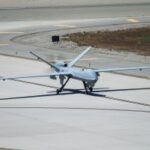During the multinational air defense exercise Andøya 2025 in Norway, the German Navy conducted a landmark test of the navalized IRIS-T SLM surface-to-air missile system aboard an F125-class frigate. The trial marks the first known deployment of this modular air defense architecture at sea and signals a significant step toward enhancing fleet-level short- to medium-range air and missile defense (SHORAD/MRAD) capabilities.
IRIS-T SLM Goes to Sea: A Strategic Leap for Modular Naval Air Defense
The IRIS-T SLM (Surface-Launched Medium range) system—developed by Diehl Defence as part of Germany’s layered ground-based air defense—has now been adapted for maritime deployment. The test aboard the Baden-Württemberg-class frigate (F125) represents a new phase in Germany’s effort to close critical capability gaps in naval SHORAD/MRAD coverage. The trial occurred during the NATO-affiliated Andøya 2025 exercise held off Norway’s coast in October 2025.
Unlike traditional ship-integrated missile systems such as ESSM or Sea Ceptor, the IRIS-T SLM is designed as a modular and relatively low-footprint solution that can be rapidly deployed using containerized launchers and distributed sensors. This makes it attractive for retrofit onto existing platforms without major structural modifications—a key consideration for navies seeking flexible upgrades amid evolving aerial threats including UAV swarms and cruise missiles.
System Configuration Aboard the F125 Frigate
The test configuration reportedly involved several containerized vertical launch units placed on the frigate’s helicopter deck or mission bay area. These launchers were integrated with a shore-based fire control node via secure datalink, simulating distributed engagement operations. While no live missile firings were confirmed during this phase of testing, simulated intercepts and sensor tracking exercises were conducted against aerial targets provided by partner nations.
The F125-class frigates are optimized for long-duration stabilization missions and feature large mission bays capable of hosting modular payloads. This made them ideal candidates for testing containerized systems like IRIS-T SLM. The class also includes advanced C2 architecture that can be interfaced with external sensor networks—critical for future cooperative engagement scenarios.
Technical Profile of the IRIS-T SLM
The IRIS-T SLM is based on the proven IRIS-T SL missile—a vertically launched variant of the original IRIS-T short-range air-to-air missile (AIM-2000). Key features include:
- Range: Up to 40 km (depending on radar support)
- Ceiling: Approx. 20 km
- Guidance: Inertial navigation with datalink updates; terminal imaging infrared seeker
- Launcher: Containerized VLS modules (typically four missiles per pod)
The system is typically paired with Hensoldt TRML-4D AESA radar or other compatible sensors for target acquisition and tracking. It supports both standalone operation and networked integration via NATO-standard interfaces such as Link-16 or national equivalents.
This makes it well-suited not only for land-based deployments—as seen in Ukraine—but also for naval use where rapid plug-and-play capability is essential.
Tactical Implications: Distributed Maritime SHORAD
The successful integration trial suggests that Germany may pursue broader adoption of containerized SHORAD solutions across its fleet. This aligns with NATO’s growing emphasis on distributed lethality and agile force protection in contested littoral environments where traditional AAW systems may be saturated or unavailable.
Key tactical advantages include:
- Scalability: Launchers can be added or removed based on mission profile
- Sustainability: Lower cost per shot compared to high-end interceptors like SM-2/3/6
- Interoperability: Compatible with joint C4ISR networks
If validated through further trials—including live-fire events—the navalized IRIS-T SLM could serve as an interim or complementary solution to more complex systems like MEADS-N or TLVS-N that have faced delays or cancellation.
A Broader Trend Toward Modular Maritime Air Defense
The German initiative mirrors similar efforts by other NATO navies experimenting with containerized or rapidly deployable SAM systems aboard auxiliary ships, corvettes, or even commercial vessels pressed into service under hybrid conflict scenarios. Examples include Norway’s NASAMS deployments aboard Coast Guard vessels and Poland’s interest in mobile CAMM launchers from MBDA.
This trend reflects growing concern over saturation attacks by low-cost drones and cruise missiles—threats that legacy CIWS or point-defense systems alone cannot adequately counter. By leveraging proven land-based systems like IRIS-T SLM in maritime roles, navies gain flexibility without waiting years for new hull designs or VLS retrofits.
Next Steps: Live-Fire Trials and Fleet Integration?
No official timeline has been released regarding follow-on tests or operational deployment plans. However, statements from Bundeswehr officials suggest continued interest in expanding modular SHORAD capabilities across both land and sea domains. Future trials will likely focus on live-fire validation under realistic maritime conditions—including electronic warfare environments—and integration into existing combat management systems such as Atlas Elektronik’s ANCS used aboard F125s.
If successful, this could lead to rotational deployment of containerized IRIS-T SLM units aboard German frigates during high-threat patrols or NATO task group operations—especially in Baltic Sea scenarios where Russian ISR/UAV activity has increased markedly since early 2024.










